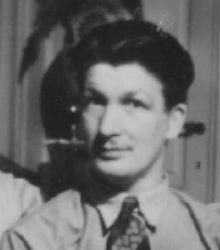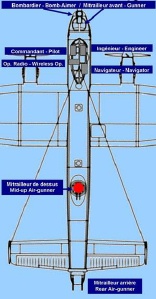Informations diverses - Diverse information
* David Yardley s'engagea en tant que mitrailleur de vol le 20 mars 1942. Il entra à la R.A.F. le 9 novembre de la même année. Lors de l'accident, il fut éjecté de l'avion
et atterrit dans un arbre, non loin des lieux de l'impact, selon les dires des témoins présents, venus secourir les éventuels survivants du crash. Deux rebecquois, Emile Hanon et Léon Decrême,
arrivés sur place découvrirent l'aviateur dans l'arbre et l'en descendirent.
Le blessé fut placé sur la dérive du gouvernail de direction qui s'était détachée de la queue de l'appareil, lors de l'accident. Ils l'emmenèrent à l'hospice de Rebecq, tenu par des religieuses et
qui servait d'hôpital de proximité, à cette époque.
D'après ses papiers personnels dont nous avons retrouvé des photocopies au cercle d'Histoire de Rebecq, ses blessures étaient graves et nombreuses, il était dans un profond coma.
Le docteur Dupureur, alors médecin exerçant à Rebecq, commença à lui administrer les soins d'urgence.
Lorsque les militaires allemands arrivèrent à l'hospice, ils ne purent que constater la gravité des blessures de David Yardley. Ils décidèrent de le transférer à l'hôpital militaire de Bruxelles.
Il y resta environ deux mois, au cours desquels, on essaya de réduire les nombreuses fractures et de réparer les dégâts occasionnés par sa chute.
Il avait le bras gauche, les deux mains et les doigts fracturés, son visage avait été écrasé et son nez avait été complètement arraché, sa mâchoire était réduite en morceaux.
Il présentait, en plus, de nombreuses contusions et blessures occasionnées par les débris qui l'avaient atteint, dont une profonde à l'omoplate. Il dû subir des greffes de peau et resta amnésique durant de nombreux mois.
Bien que ses blessures n'étaient pas encore guéries et ses fracture ressoudées, Yardley fut expédié dans le Stalag Luft 3, situé à Sagan, aujourd'hui en Pologne. Ce camp était essentiellement réservé aux aviateurs
britanniques et américains et était régi par la Luftwaffe, ce qui permit aux 10.500 prisonniers sur place, en fin 1944, d'avoir un traitement plus humain que celui imposé dans d'autres stalags.
Grâce à l'entraide et à la camaraderie qui régnait dans ce camps, David Yardley put lentement se remettre de ses blessures. Un prisonnier lui écrivait les lettres destinées à Gracie, sa femme.
Il fallut qu'il attende que sa mâchoire soit complètement ressoudée pour qu'il reçoive des fausses dents. Lorsqu'il reviendra au pays, il devra subir un certain nombre
d'opérations pour lui réduire les fractures qui s'étaient mal ressoudées et les médecins lui refirent un nouveau visage.
Durant toute sa captivité, dans les lettres qu'il envoyait à sa femme, Yardley évoqua le fait de ne plus se souvenir de certaines choses. S'il savait qu'il était marié et avait deux fils, in ne se souvenait plus de leur visage, et cela le troublait très fort,
au point de le rendre dépressif. Il dut attendre quelques mois avant de recevoir une lettre de son épouse, car celle-ci avait une manière particulière de former le chiffre "7", et cela a prêté à confusion, lorsque le courrier arrivait en Allemagne. de ce fait, de nombreuses lettres furent égarées et David se demandait si on se souvenait de lui...
Alors que les Alliés se rapprochaient de l'Allemagne, début 1945, tant de l'Ouest que de l'Est, les prisonniers des camps et des Stalags furent regroupés et forcés par leurs gardiens à marcher vers des destinations
souvent inconnues, durant des jours et des jours, dans des conditions climatiques extrêmes (c'était l'hiver). Les faibles, qui s'arrêtaient épuisés, étaient abattus instantanément et laissés sur place.
David, dont la santé n'était pas bonne, afin d'éviter de rester à la traîne et de risquer de se faire tuer choisit de s'échapper, en compagnie de six autres détenus. Ils réussirent à s'éclipser et arrivèrent dans un village
où ils furent recueillis, nourris et cachés par un prêtre jusqu'à ce que les troupes de l'armée russe arrivent et les libèrent. Les fuyards eurent la chance d'être emmenés vers Odessa, d'où ils purent monter sur un navire à destination du Moyen-Orient.
Yardley fut rapatrié en Angleterre dans le courant du mois d'avril 1945 et retrouva son épouse et ses enfants, après avoir passé un certain temps à l'hôpital.
David Yardley revint en Belgique revoir les personnes qui l'avaient aidé lors de l'accident du 28 mai 1944. Des relations furent entretenues entre eux jusque dans les années 1970.
* David Yardley made a commitment as air-gunner on March 20th, 1942. He entered the R.A.F. on November 9th of the same year. During the accident, he was ejected from the plane
and landed in a tree, not far from the place of the impact, according to the statements of the present witnesses, arrived to help the possible survivors of the crash. Two villagers, Emile Hanon and Léon Decrême,
arrived on the spot discovered the airman in the tree and took him down from it.
The wounded airman was placed on the tail of the rudder which had got loose from plane, during the accident. they took him to the hospital of Rebecq, held by nuns and which served as hospital of
closeness, in this period.
According to his personal papers photocopies of which we found in the association of History of Rebecq, his wounds were grave and numerous, he was in a profound coma.
Doctor Dupureur, then doctor practicing to Rebecq, began to administer him the emergency care.
When the German soldiers arrived there, they were able to only see the gravity of David Yardley's wounds. They decided to transfer him to the military hospital of
Brussels. He stayed there approximately two months, during which, the doctors tried to reduce the numerous fractures and to repair the damages caused by his fall.
He had the left hand, both hands and fingers broken, the face had been crushed and its nose had been completely torn away, his jaw was smashed.
He presented, besides, numerous bruises and wounds caused by the fragments which had reached him, of which a deep one in the shoulder blade.
He had to undergo skin grafts and remained amnesic for numerous months.
Although its wounds were not cured yet and breaks itself restored, Yardley was sent in the Stalag Luft 3, situated to Sagan, today in Poland.
This camp was essentially reserved for the British and American airmen and was governed by Luftwaffe, what allowed to the 10.500 on-the-spot prisoners, at the end of 1944, to have a treatment more human than that imposed in other stalags.
Thanks to the mutual aid and to the good-companionship which reigned in it camps, David Yardley was slowly able to recover from his wounds. A prisoner wrote
the letters intended to his wife. He had to wait that his jaw was completely restored so that he receives false teeth. When he will return to the country, he will have to undergo a number of operation to reduce the fractures which had badly mended and the doctors redid him a new face.
During all his captivity, in the letters which he sent to his wife, Yardley evoked the fact of not remembering any more certain things. If he knew that he
was married and had two sons, in did not remember any more their face, and it disturbed him very hardly, in to make him depressive. He had to wait for a few months
before receiving a letter of Grace(, his wife, because this one had a particular way of forming the figure " 7 ", and it was open to misinterpretation, when the mail
arrived in Germany. Therefore, numerous letters were misled and David wondered if we remembered him...
While the Allies got closer to Germany, at the beginning of 1945, so from West as East, the prisoners of camps and Stalags were grouped and forced by their guards to walk towards often
unknown destinations, for days and days, in extreme weather conditions (it was the winter). Weak ones, which stopped exhausted, were immediately shot down and left on the spot.
David, whose health was not good, to avoid staying lagging behind and risking be killed, chooses to escape, together with six other prisoners. They managed to make off and arrived in a village
where they were welcomed, fed and hidden by a priest until troops of the Russian army arrive and release them. The fugitives had the opportunity to be taken towards Odessa, where from they were
able to rise on a ship reaching to the Middle East.
Yardley was repatriated in England during April 1945 and found his wife and his children, having spent some time to the hospital.
David Yardley came back in Belgium where he seen back the people whom helped him, when happened the crash of the 28th of May 1944.

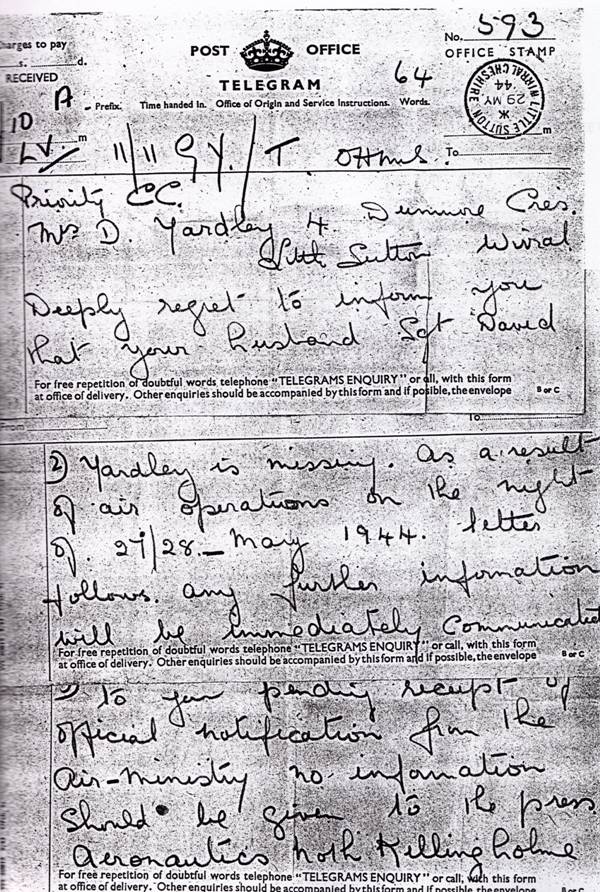
Premier télégramme envoyé par la RAF à Grace Yardley, lui annonçant la disparition de son mari
Firs telegram sent by RAF to Grace Yardley, announcing her disapearance of her husband
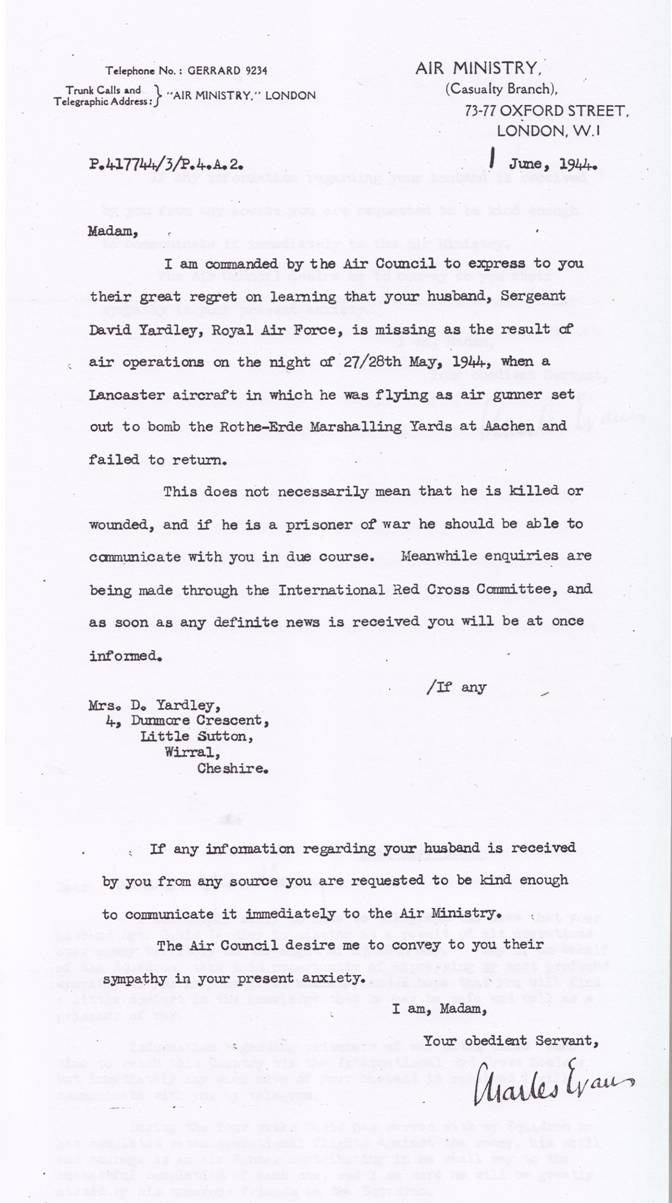
Communication officielle de la disparition de David Yardley -
Official communication of Yardley's disapearance.
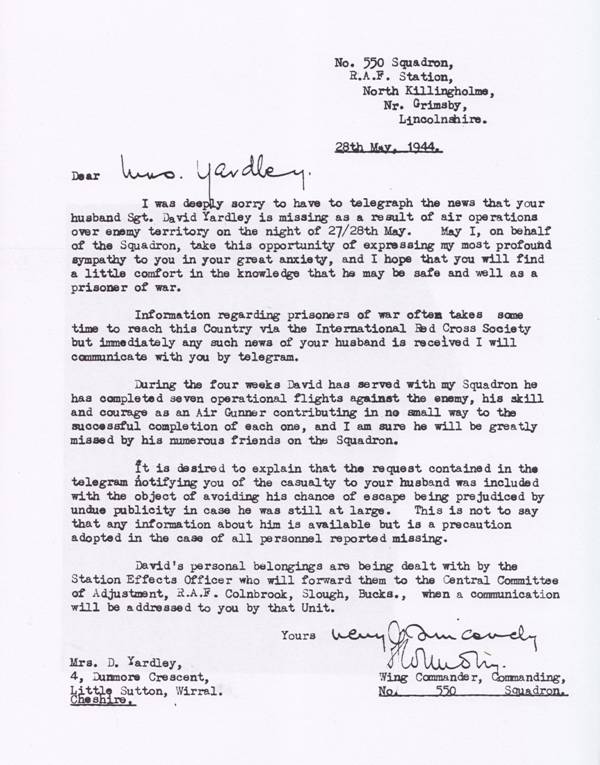
Lettre du commandement du 550th annonçant que Yardley n'est pas revenu de mission
Letter form 550th Command, sayin Yardley is "Missing"
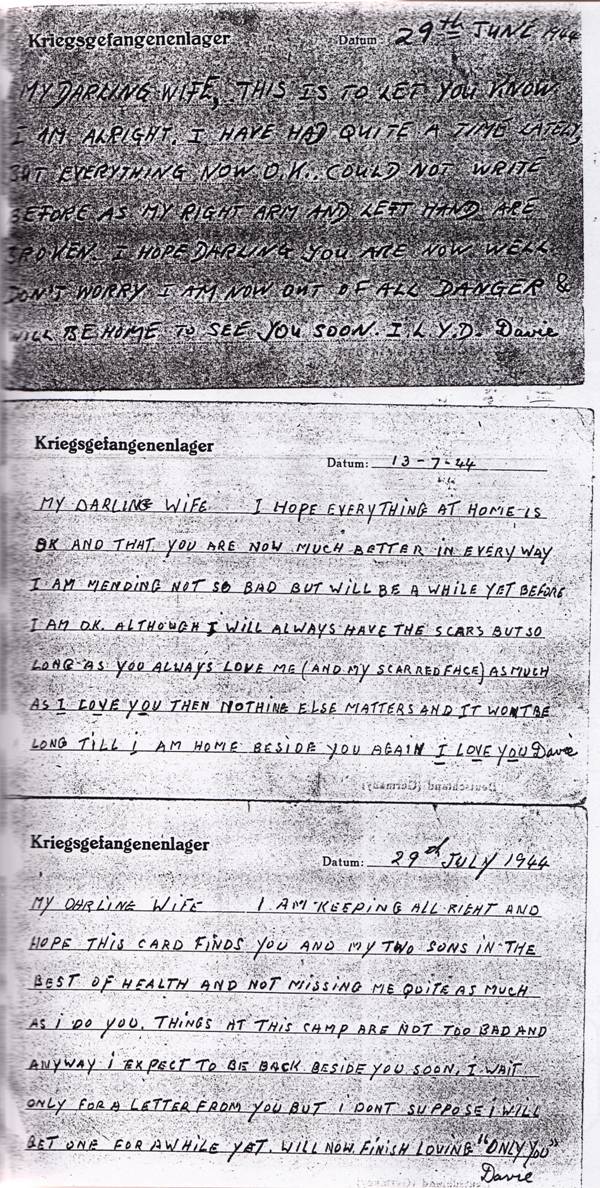
Premières lettre de David, envoyées à son épouse depuis le Stalag III
First letters sent to his wife from the Stalag III
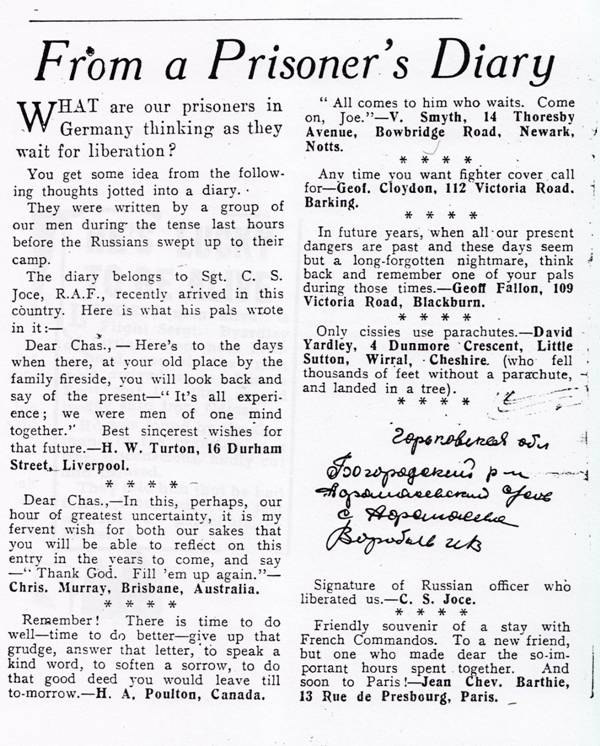
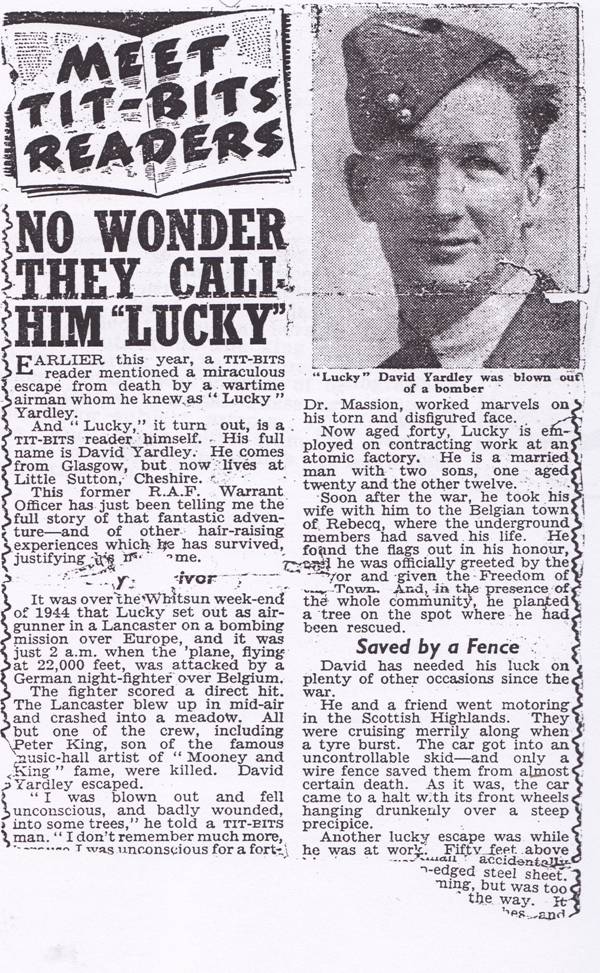
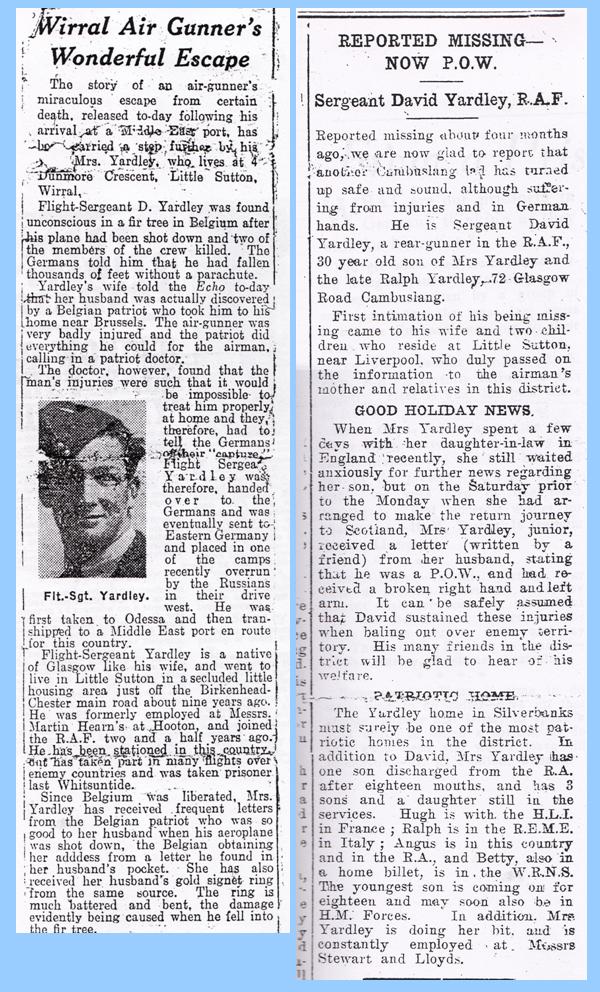
Articles de journaux annonçant que Yardley a été déclaré manquant
Newspaper articles announcing Yardley is missing
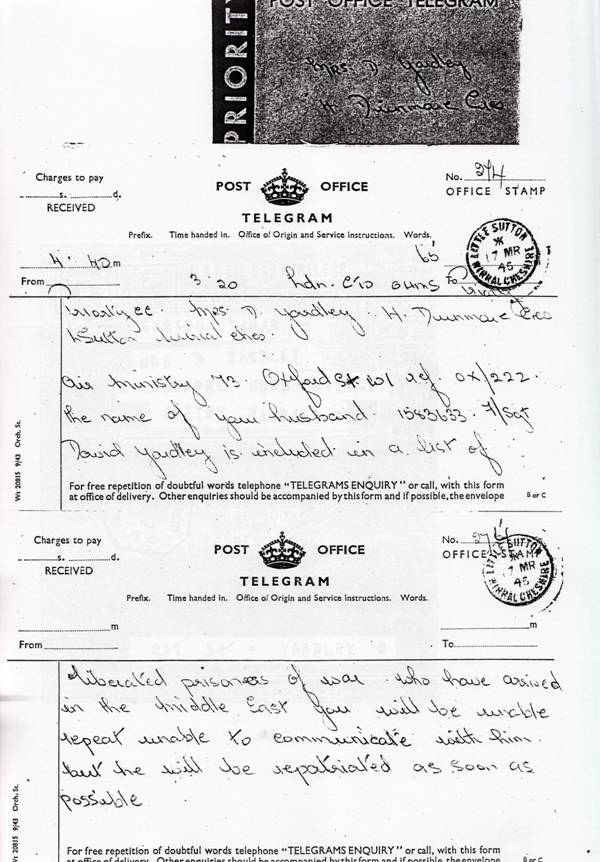
Télégramme du 17/mars 1945, annonçant la libération de Yardley
Telegram dated of Marsh 17th 1945, announcing Yardley is released
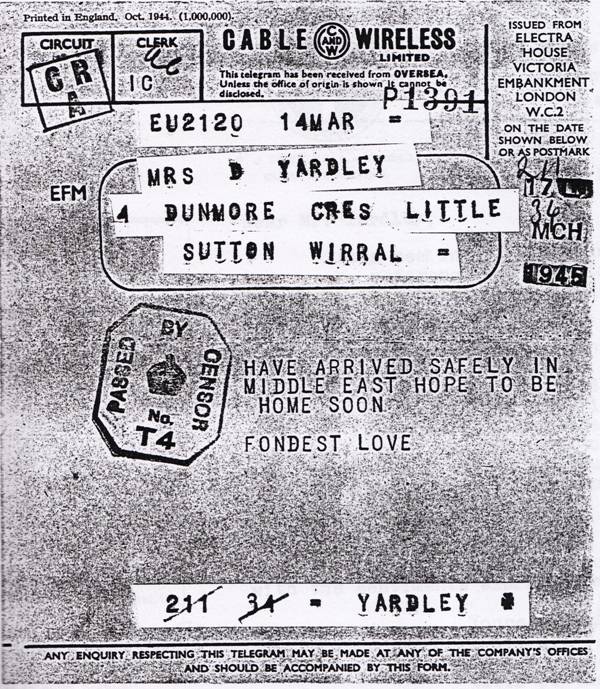
Télégramme de Yardley disant qu'il va bien et qu'il se trouve au Moyen-Orient
Telegram sent by Yardley saying he is safe and stay in Middle-East
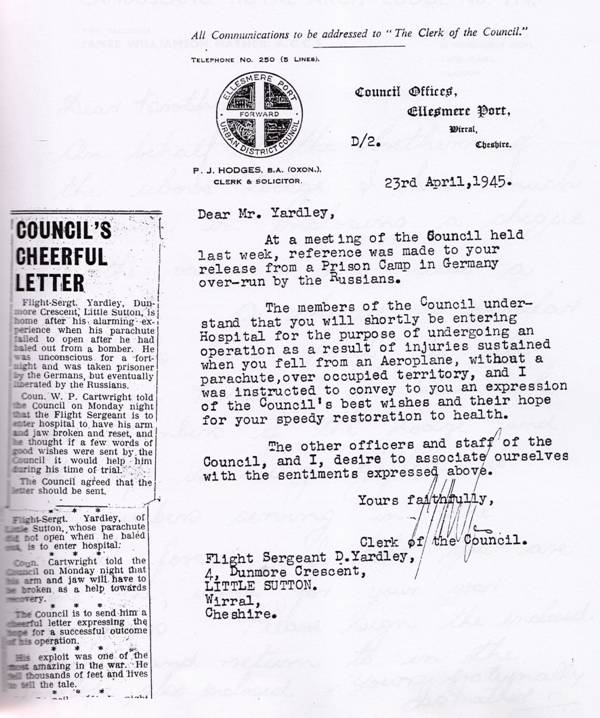
Lettre de félicitation du Conseil Minicipal de Wirral, lui souhaitant un prompt rétablissement
Cheering letter to D Yardley from the Clerks Council of Wirral (Cheshire)
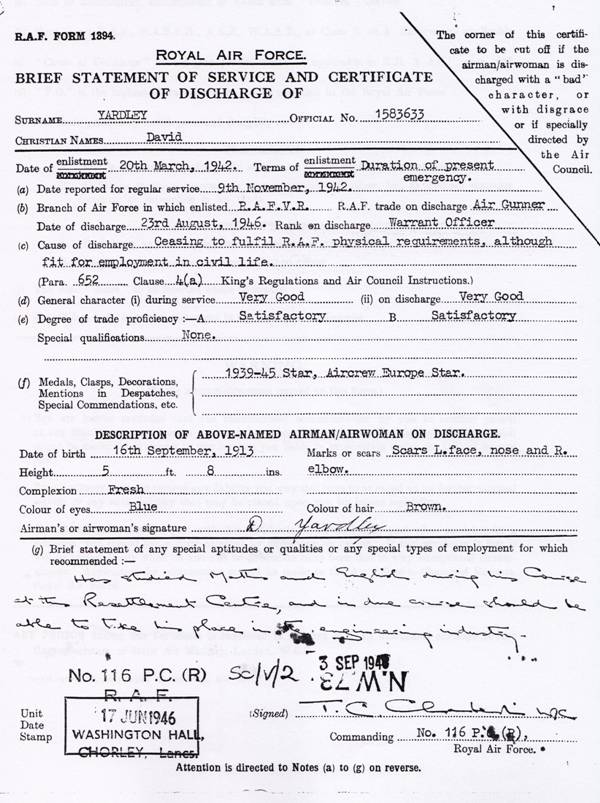
Attestation de démobilisation de David Yardley - Certificate of discharge of David Yardley
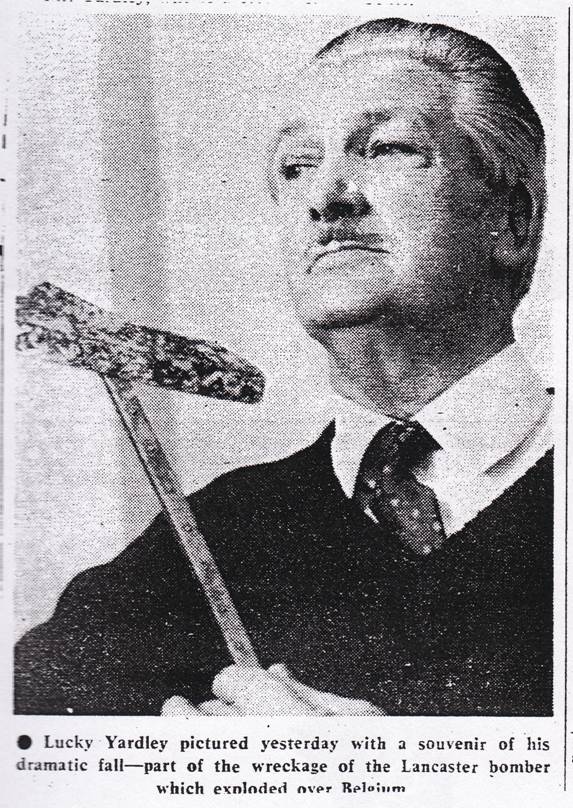
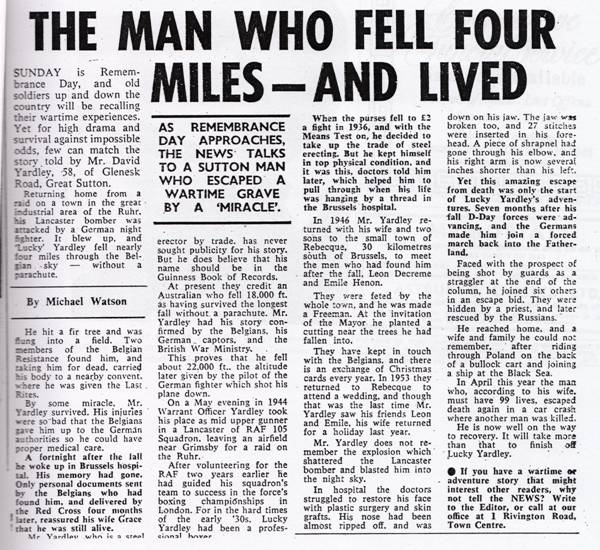
* Article d'un journal de 1971 rappelant l'histoire de David - * Press article of 1971 relating the David Yardley's story
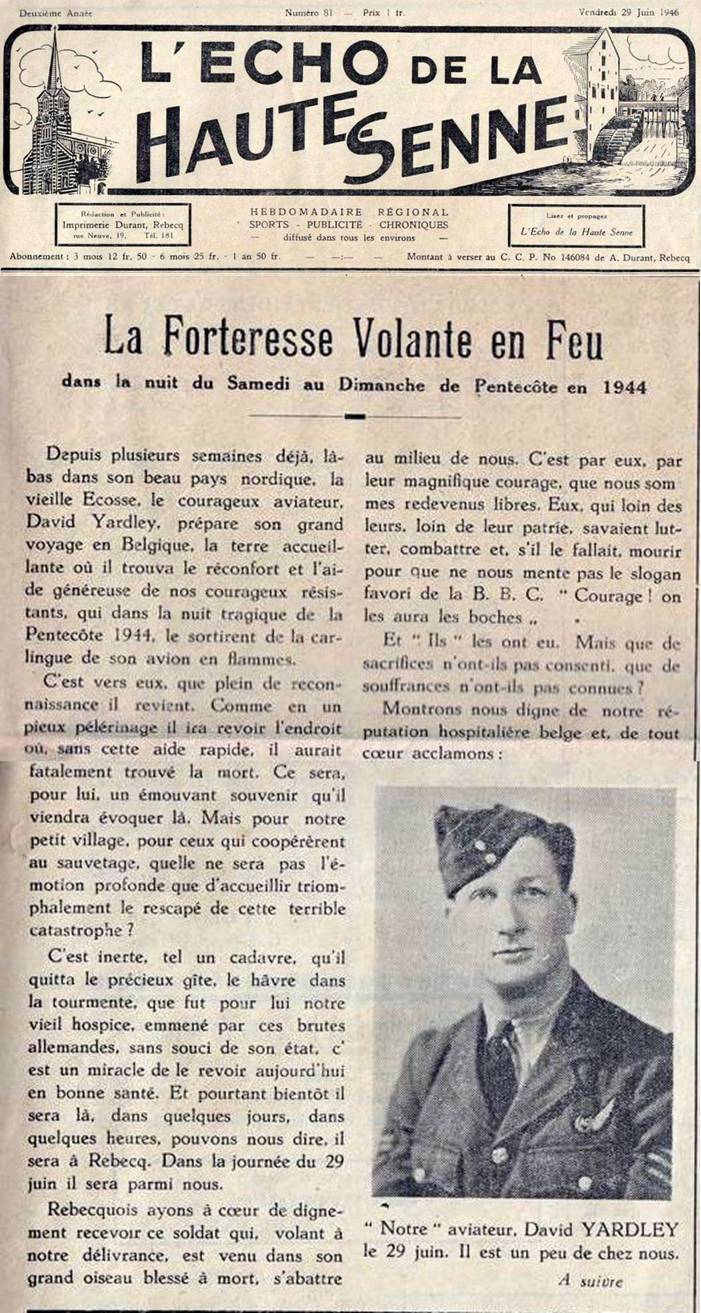
Article de "L'Echo de la Haute Senne" du 29 juin 1946, annonçant l'arrivée de D. Yardley à Rebecq
Local press article
of May 29 1946, telling D. Yardley will come back soon to Rebecq.
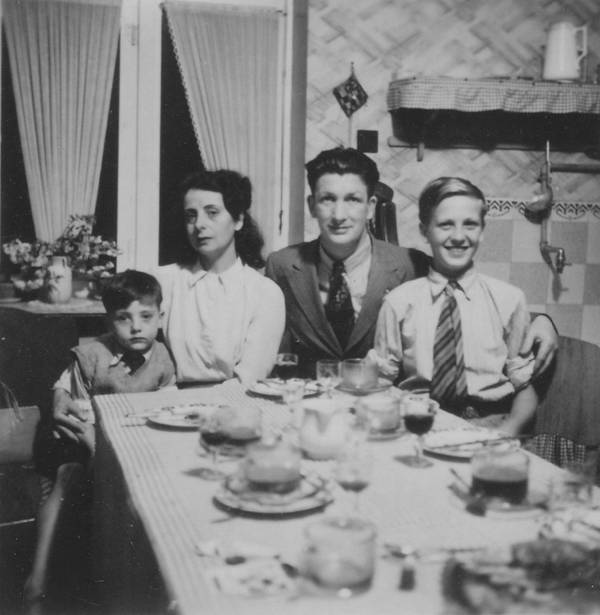
Photo prise en 1946, chez Emile Hanon où les Yardley ont rendu visite
Picture taken, to Emile Hanon's home, where the Yardley visited in 1946
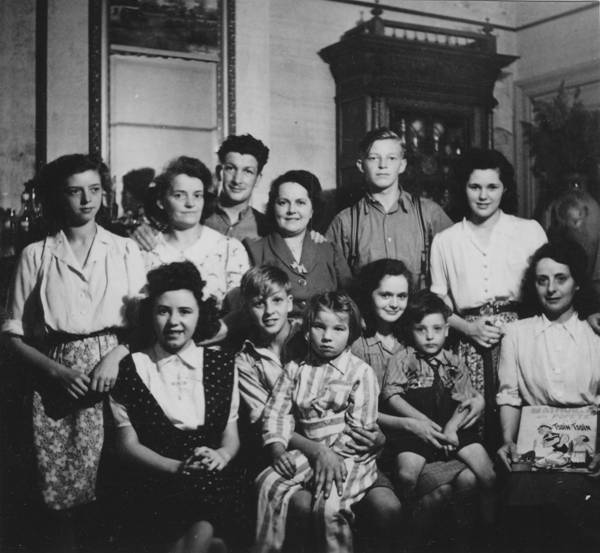
Les familles Hanon et Yardley ensemble - The families Hanon and Yarley together
De gauche à droite, assis - From left to right, seated: : une jeune amie, Ralf Yardley, Louisa De Braeckeleer,
Cécile Hanon, Bruce Yardley et Grace Yardley. Debout - Standing up: Josette Decrême, David Yardley, Yvonne Hanon, Jacques Decrême et Paulette Hanon
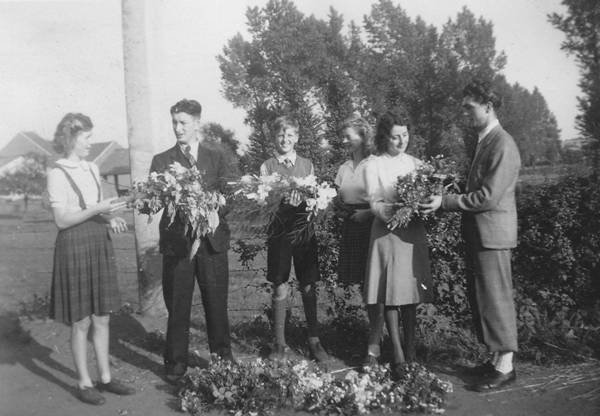
David pose des fleurs à l'endroit où il fut découvert par les résistants Hanon et Decrême
David lays flowers to the place where he was found by resistants Hanon and Decrême
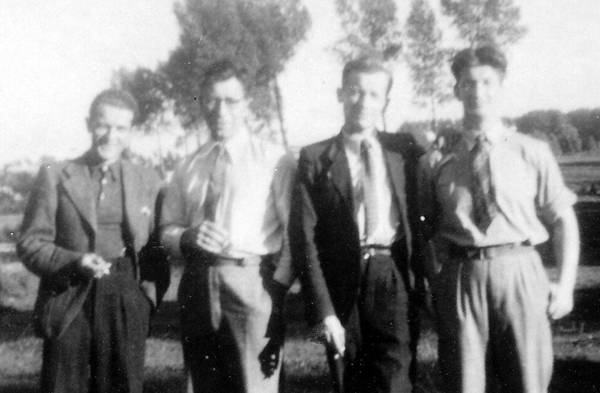
David avec trois de ses sauveteurs: à gauche, Léon Decrême - David with three of him rescuers: at left, Léon Decrême
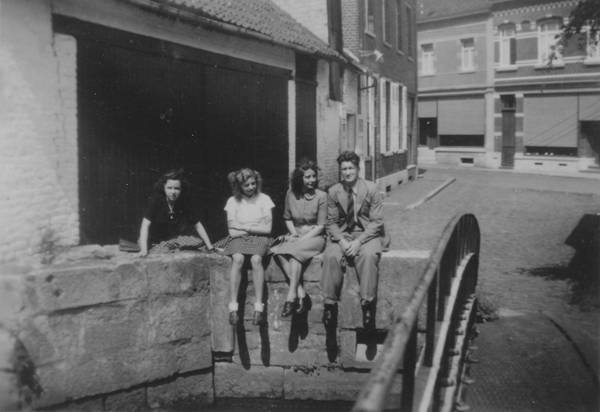
David en compagnie de jeunes filles de Rebecq - David with joung girls of Rebecq
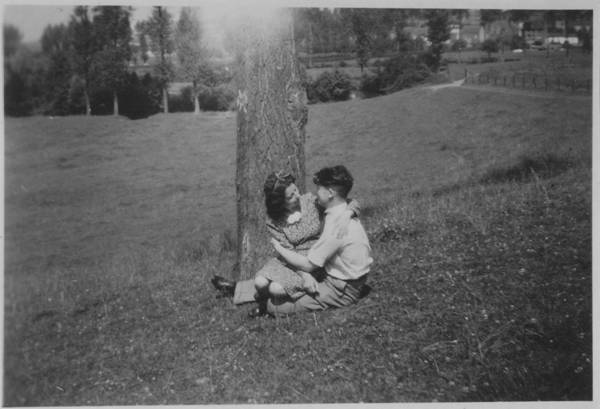
David et Garce Yarley, dans la prairie où il est tombé - David and Grace Yardley, in the meadow where he fell
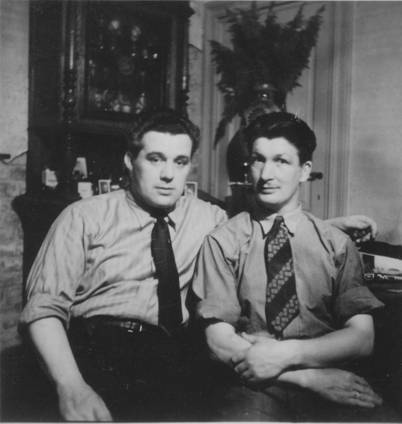
Emile Hanon et David
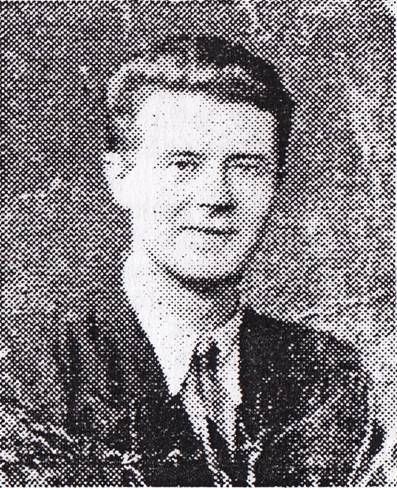
Léon Decrême
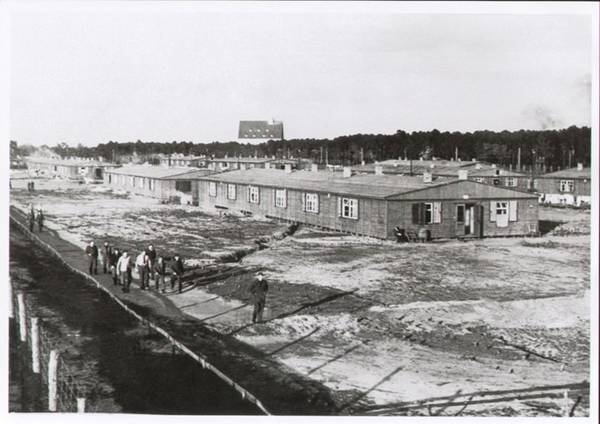
Le Stallag Luft III, à Sagan (Pologne) où David fut détenu - Stallag Luft III, Sagan (Poland) where David was prisonner
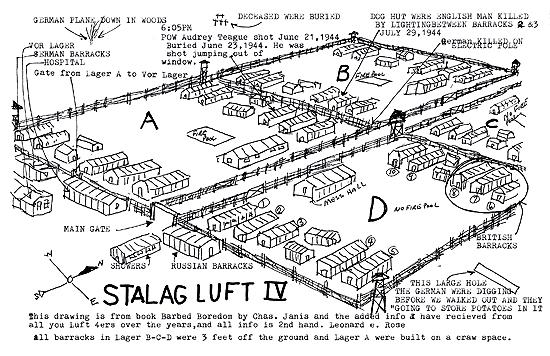
Plan du Stallag III

L'appel, au Stallag III - Appeal to Stallag III
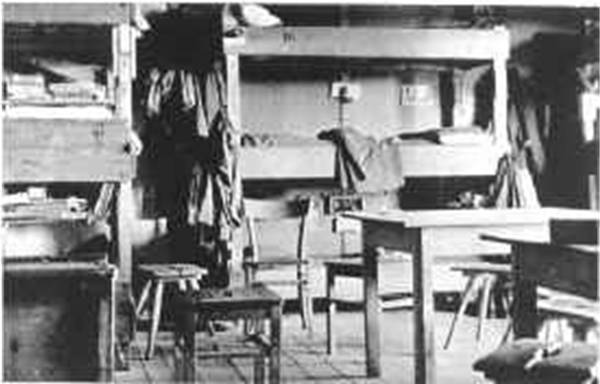
Une chambrée, à Sagan - A barrack, to Sagan
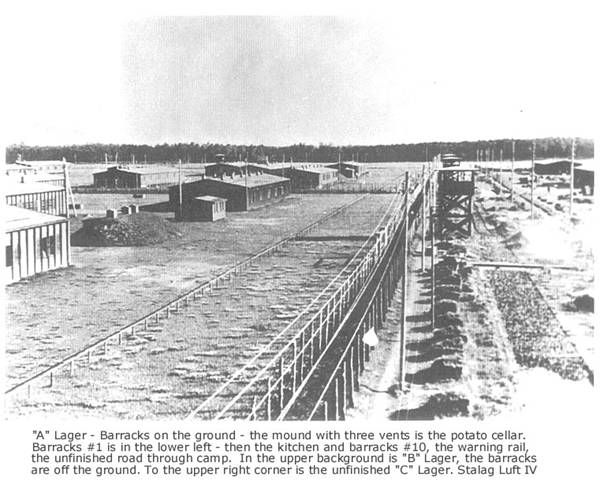
Vue du camp de Sagan - Vue of the camp of Sagan
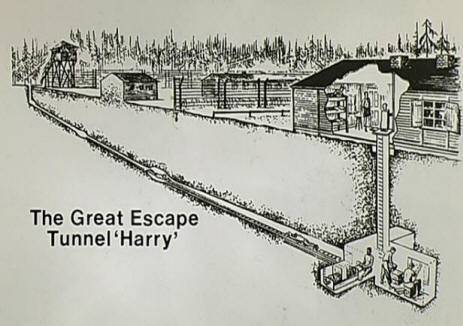
Plan du tunnel qui a permis aux prisonniers de s'échapper du Stalag III. Ils furent presque tous repris
Plan of the tunnel which allowed the prisoners to escape from the Stalag III. They were almost all taken back
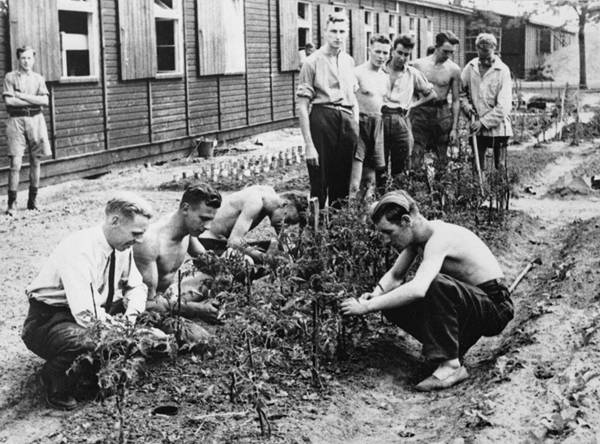
Les aviateurs britanniques et américains faisant du jardinage, Ils déversaient la terre extraite du tunnel sur les plate-bandes
de légumes
The British and American airmen gardening. They spilled the earth extracted from the tunnel on the beds of vegetables
* Plusieurs articles de journaux de l'époque racontent que David Yardley aurait été éjecté lors de l'explosion en vol du Lancaster JA 712, lorsque celui-ci a été atteint par le chasseur
allemand. Il aurait fait une chute de 22.000 pieds 7.000 m pour atterrir dans un arbre. Cette thèse n'est pas crédible si l'on sait qu'Elie Molnar, le bombardier, a pu sauter de l'avion et a
atterrit à environ deux kilomètres du point d'impact au sol de l'avion, et par conséquent de l'endroit où est tombé Yardley.
D'autre part, si l'avion avait explosé en vol, Molnar aurait eu le sort analogue de ses compagnons de vol. De plus, la carlingue de l'avion et les débris ont été éparpillés sur une surface qui
n'excédait pas 20 hectares.
Si l'avion avait explosé à une telle altitude, les débris auraient été retrouvés à plusieurs kilomètres. On peut penser qu'il y a eu une explosion en vol, mais pas de l'avion entier et qu'il a fait
une descente rapide qui a laissé le temps au bombardier Molnar de sauter en parachute. Quant à David Yardley, il a été probablement éjecté de son poste de mitrailleur de dos lorsque l'avion a touché le sol, comme l'a été
W G Upton, le mitrailleur de dos de l'avion tombé à Jalhay. N'oublions pas que David avait perdu la mémoire de ce qui s'était passé.
* Several newspaper articles of time tell that David Yardley would have been ejected during an explosion during flight of the Lancaster JA 712, when this one was shot by the German fighter.
He would have had a fall of 22.000 feet (7.000 m) to land in a tree. This thesis is not credible if we know that Elie Molnar, the bomber, was able to jump of the plane and has lands in approximately
two kilometers of the impact point on the ground of the plane, and consequently of the place where fell Yardley.
On the other hand, if the plane would have during flight exploded, Molnar would have had the similar fate that his companions of flight. Furthermore, the cabin of the plane and the wrecks
were scattered on a surface which not exceeded 20 hectares.
If the plane had exploded at such a height, fragments would have been found round of several kilometers. We can think that there was an explosion during flight, but not of the whole plane and
that he made a fast descent which left the time to the bomber Molnar to jump with is parachute. As for David Yardley, he was probably ejected from his post of mid-up gunner when the plane crashed on
the ground, as was him, W G Upton, the mid-up gunner of the plane fallen to Jalhay. Let us not forget that David had lost the memory of what had happened.
We will remember him! - Nous nous souvenons de lui!



